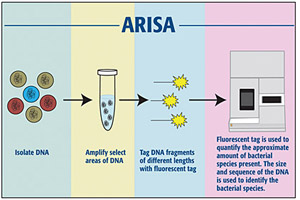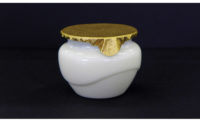
|
| Automated ribosomal intergenic spacer analysis is a new method of testing for bacterial strains. It is now being applied to cheese. ARISA has allowed for increased accuracy in the area of cheese defects and gas formers. |
Recent advances in dairy science and manufacturing technologies are helping to lead the way to better, safer and more economical products. In particular, advances in membrane technology, microbiological techniques and analytical testing are helping the dairy industry to produce new products, improve processing efficiency and gain greater control over manufacturing processes. As the science continues to grow, we are entering an exciting time for the dairy industry.
Advances in membrane technology are particularly exciting as ideas from other fields are now being applied to the dairy protein fractionation and concentration areas. University of Wisconsin-Madison Food Science professor Mark Etzel has developed a charged membrane technology that separates proteins from lactose, non-protein nitrogen and minerals based on molecular size and charge.
The charged membrane technology has two applications: fractionation and concentration. If a charged membrane system is used for concentration, however, higher flow rates can be achieved along with potentially less wastewater generation and lower energy consumption.
Fractionating whey proteins
Fractionation on the other hand, is less widely used in the dairy industry due to the fact that whey proteins are mostly of a similar size, making them hard to separate. By using charge differences, Etzel uses the charged membrane system to fractionate similarly sized whey proteins. Etzel’s charged membrane system is available for licensing and the Center for Dairy Research pilot plant is able to perform limited product testing and scale up on this system.
Advances in microbiology are also paving the way for more accurate and economical methods of testing. For example, ARISA (automated ribosomal intergenic spacer analysis), a new method of testing for bacterial strains is now being applied to cheese, which has allowed for increased accuracy in the area of cheese defects and gas formers.
CDR Senior Scientist Mark Johnson has been using ARISA in his study of gas former defects in cheese. This new method allows for him to quickly isolate the RNA present in the cheese and then determine the strain, or strains, of bacteria responsible for gas formation. The ARISA method is extremely accurate as each bacterium has its own unique RNA, allowing Johnson to pinpoint the exact bacteria responsible for gas formation.
Previous methods would have required Johnson and his team to spend weeks developing colonies on agar plates before further testing the colonies to identify strains. This new method allows for results in less than 48 hours. The ARISA method (and other DNA/RNA based techniques) will be a time-saver for the industry as well as providing a more accurate approach to determine what microorganisms are affecting dairy product safety and quality.
XRF and titration methods
Analytical techniques are also rapidly changing as new technologies become available. Systems such as the X-ray fluorescence spectrometry (XRF) method of rapid sodium testing in cheese are being studied at CDR, with the hopes that companies will be able to better monitor the consistency of their products.
Acid-base buffering (titration) methods have also been developed at CDR to regulate the melt and texture of cheese through better control of pH and the amount of calcium cross-linking of the caseins. Additionally, new rheological methods are helping researchers to better understand the impact of cheese milk fortification on curd formation, helping to reduce fat losses and cheese yield. Ultimately, these advances can help companies achieve better control over key composition or performance targets, allowing manufacturers to maximize their yield while making better, more consistent products.
Whether it is through new separation technologies or advanced testing methods, CDR and the dairy research community are always working to move the dairy industry forward.




